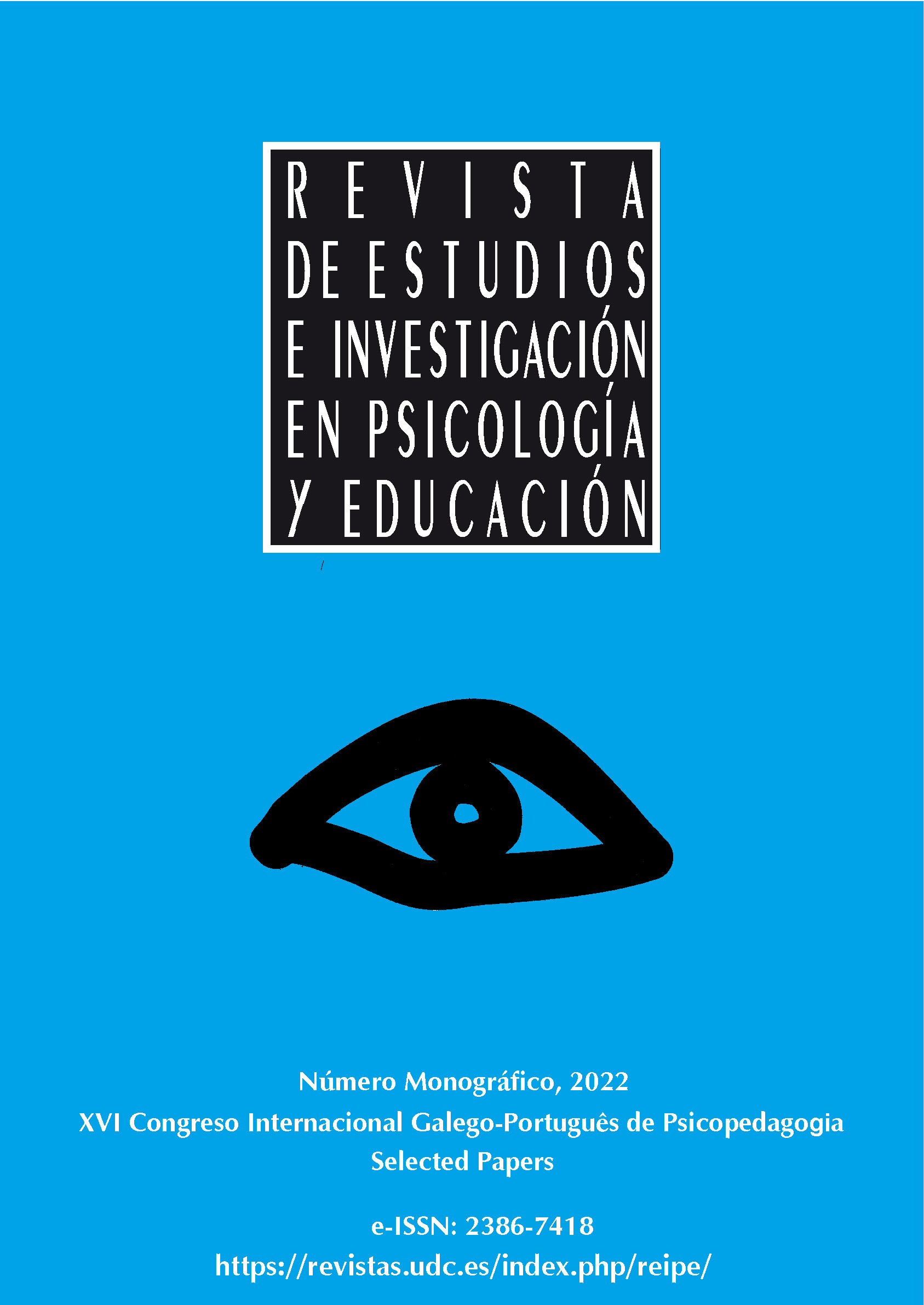Ciberabuso en el noviazgo: ¿Cuál es la relación con la sensibilidad moral en una muestra de estudiantes universitarios?
Contenido principal del artículo
DOI:
https://doi.org/10.17979/reipe.2022.9.0.8911Resumen
A presente investigação procurou explorar a relação entre ciberabuso no namoro e sensibilidade moral numa amostra de estudantes universitários. A amostra foi constituída por 239 estudantes universitários com idades compreendidas entre os 17 e os 49 anos (M = 21.50; DP = 4.70). Foram utilizados como instrumentos a Escala de Sensibilidade Moral (ESE), o Questionário sobre Ciberabuso no Namoro (CibAN) e um questionário sociodemográfico. Os principais resultados sugerem que existem diferenças em função do sexo nas dimensões Ler e Expressar Emoções, Tomar Perspetiva dos Outros, Cuidado ao conectar-se com outros e Gerar Interpretações e Opções, sendo que o sexo feminino, de um modo geral, apresentou níveis superiores comparativamente ao sexo masculino. Relativamente à variável ciberabuso no namoro, foram encontradas diferenças estatisticamente significativas em função do sexo nas dimensões vitimação – agressão direta e perpetração – agressão direta, sendo que o sexo masculino apresentou maior pontuação face ao sexo feminino em ambas. Verificaram-se ainda correlações negativas significativas entre dimensões do ciberabuso e dimensões da sensibilidade moral. Face aos resultados evidenciados, considera-se de extrema relevância a implementação de programas de intervenção direcionados para o desenvolvimento de competências ligadas à sensibilidade moral pois estas parecem permitir o desenvolvimento de comportamentos pró-sociais, contribuindo assim para a diminuição de comportamentos desviantes.
Descargas
Detalles del artículo
Referencias
Azevedo, M. C. (2019). Ethical Sensitivity Scale (Unpublished manuscript). Departamento de Educação e Psicologia, Universidade de Trás-os-Montes e Alto Douro.
Bandura, A. (1999). Moral disengagement in the perpetration of inhumanities. Personality and Social Psychology Review, 3(3), 193-209. https://doi.org/10.1207/s15327957pspr0303_3
Bennett, D. C., Guran, E. L., Ramos, M. C., & Margolin, G. (2011). College students' electronic victimization in friendships and dating relationships: Anticipated distress and associations with risky behaviors. Violence and Victims, 26(4), 410-429. https://doi.org/10.1891/0886-6708.26.4.410
Borrajo, E., Gámez-Guadix, M., & Calvete, E. (2015a). Cyber dating abuse: Prevalence, context, and relationship with offline dating aggression. Psychological Reports: Relationships & Communications, 116(2), 565-585. https://doi.org/10.2466/21.16.PR0.116k22w4
Borrajo, E., Gámez-Guadix, M., Pereda, N., & Calvete, E. (2015b). The development and validation of the Cyber Dating Abuse Questionnaire among young couples. Computers in Human Behavior, 48, 358-365. https://doi.org/10.1016/j.chb.2015.01.063
Caridade, S. M., & Braga, T. (2019). Versão portuguesa do Cyber Dating Abuse Questionaire (CDAQ) – Questionário sobre Ciberabuso no Namoro (CibAN): Adaptação e propriedades psicométricas. Análise Psicológica, 1(36), 93-105. https://doi.org/10.14417/ap.1543
Cuadrado-Gordillo, I., & Fernández-Antelo, I. (2019). Analysis of moral disengagement as a modulating factor in adolescents’ perception of cyberbullying. Frontiers in Psychology, 10, 1-12. https://doi.org/10.3389/fpsyg.2019.01222
Cuadrado-Gordillo, I., Fernández-Antelo, I., & Parra, M. G. (2020a). Moral disengagement as a moderating factor in the relationship between the perception of dating violence and victimization. International Journal of Environmental Research and Public Health, 17, 1-14. https://doi.org/10.3390/ijerph17145164
Cuadrado-Gordillo, I., Fernández-Antelo, I., & Parra, M. G. (2020b). Moral development in adolescents as a key indicator for the prevention of violent behavior in their couples’ relationships. European Journal of Teaching and Education, 2(3), 50-58. https://doi.org/10.33422/ejte.v2i3.494
Cutbush, S., Williams, J., Miller, S., Gibbs, D., & Clinton-Sherrod, M. (2018). Longitudinal patterns of electronic teen dating violence among middle school students. Journal of Interpersonal Violence, 00(0), 1-21. https://doi.org/10.1177/0886260518758326
Durán, M., & Martínez-Pecino, R. (2015). Ciberacoso mediante teléfono móvil e internet en las relaciones de noviazgo entre jóvenes. Comunicar, 22(44), 159-167. https://doi.org/10.3916/C44-2015-17
Espinosa-Pike, M., Aldazabal, E., & Martín-Arroyuelos, A. (2012). Influence of gender and ethical training on university teachers sensitivity towards the integration of ethics in business studies. Journal of Academic Ethics, 10, 9–25. https://doi.org/10.1007/s10805-012-9151-x
Gilligan, C. (1982). In a different voice: Psychological theory and women’s development. Harvard University Press.
Golami, K., & Tirri, K. (2012). The cultural dependence of the Ethical Sensitivity Scale questionnaire: The case of Iranian Kurdish teachers. Education Research International, 1-10. https://doi.org/10.1155/2012/387027
Hinduja, S., & Patchin, J. W. (2020). Digital dating abuse among a national sample of U.S. youth. Journal of Interpersonal Violence, 00(0), 1-21. https://doi.org/10.1177/0886260519897344
Hood, M., & Duffy, A. L. (2018). Understanding the relationship between cyber-victimisation and cyber-bullying on social network sites: The role of moderating factors. Personality and Individual Differences, 133, 103-108. https://doi.org/10.1016/j.paid.2017.04.004
Kohlberg, L. (1974). Education, moral development and faith. Journal of Moral Education, 4(1), 5-16. https://doi.org/10.1080/0305724740040102
Machimbarrena, J. M., Calvete, E., Fernández-González, L., Álvarez-Bardón, A., Álvarez-Fernández, L., & González-Cabrera, J. (2018). Internet risks: An overview of victimization in cyberbullying, cyber dating abuse, sexting, online grooming and problematic internet use. International Journal of Environmental Research and Public Health, 15(11), 1-15. https://doi.org/10.3390/ijerph15112471
Marôco, J. (2018). Análise estatística com o spss statistics (7ª Ed.). ReportNumber.
Peterson, J., & Densley, J. (2017). Cyber violence: What do we know and where do we go from here? Aggression and Violent Behavior, 34, 193-200. https://doi.org/10.1016/j.avb.2017.01.012
Rest, J. R. (1984). Background: Theory and research. In J. R. Rest & D. Narváez (Eds.), Moral development in the professions: Psychology and applied ethics (pp. 1-26). Lawrence Erlbaum Associates, Inc.
Sánchez-Jiménez, V., & Muñoz-Fernández, N. (2021). When are sexist attitudes risk factors for dating aggression? The role of moral disengagement in Spanish adolescents. International Journal of Environmental Research and Public Health, 18, 1-14. https://doi.org/10.3390/ijerph18041947
Stankovska, G., Dimitrovski, D., Memedi, I., & Ibraimi, Z. (2019). Ethical sensitivity and global competence among university students. In N. Popov et al. (Eds.), Global education in practice: Teaching, researching, and citizenship. Bulgarian Comparative Education Society.
Tirri, K., & Nokelainen, P. (2011). Ethical Sensitivity Scale. In K. Tirri & P. Nokelainen (Eds.), Measuring multiple intelligences and moral sensitivities in education (pp. 59-76). Sense Publishers.
Wolford-Clevenger, C., Brasfield, H., Febres, J., Elmquist, J., Brem, M., & Shorey, R. C. (2015). An examination of the Partner Cyber Abuse Questionnaire in a college student sample. Psychology of Violence, 6(1), 156-162. https://doi.org/10.1037/a0039442
Zweig, J. M., Dank, M., Yahner, J., & Lachman, P. (2013). The rate of cyber dating abuse among teens and how it relates to other forms of teen dating violence. Journal of Youth Adolescence, 42, 1063-1077. https://doi.org/10.1007/s10964-013-9922-8



